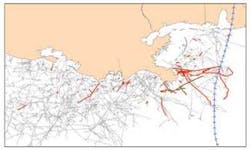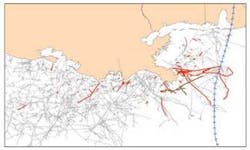Study details GoM pipeline hurricane damage
Abdel Ghoneim, Det Norske Veritas
The US Minerals Management Service awarded DNV two contracts in 2005 and 2006 for damage assessment of the pipelines in the Gulf of Mexico, resulting from the passage of Hurricanes Ivan in September 2004 and Katrina and Rita in late August and September 2005. The objective of these assessments is to determine the extent of the damage to the pipelines and assess the hurricane preparedness and response procedures in order to be better prepared in the future to minimize the damage to the pipelines while reducing disruption of the Gulf’s oil and gas supply.
Hurricane Ivan, the subject of the first study, was a classical, long-lived Cape Verde hurricane that reached category 5 strength three times, and was a category 3 hurricane at landfall. For the period of 1851-2004, Hurricane Ivan was twenty-seventh out of approximately 1,325 storm systems, ranked by the Saffir-Simpson category at landfall and the measured minimum barometric pressure. Both Katrina and Rita are believed to have set new records in terms of hurricane strength and associated damage to offshore and coastal areas.
Ivan project
The project scope included an assessment of the pipeline infrastructure damage with an attempt to identify the root causes of the damage through analyses of the damage reports, interviews with pipeline operators, and maintaining active involvement in industry hurricane-related workshops. The scope also included investigation of current design, operation, maintenance, and hurricane preparedness and response practices by GoM pipeline operators. The results were collected and evaluated through technical and graphical analyses to determine possible revisions to codes and practices with the intent of better protecting pipelines during subsequent major hurricane events.
The MMS Gulf of Mexico Regional Office (GOMR) conducts all leasing and resource management functions on the GoM Outer Continental Shelf. The OCS consists of submerged federal lands off the United States coasts. MMS leases these federal offshore areas for exploration and production and closely monitors OCS operations to protect coastal environments. Management of the production of roughly 30% of the US oil supply at around 1.5 MMb/d and 22% of the US natural gas supply at approximately 10 bcf/d, is the responsibility of the MMS. The GoM has 43 million acres under lease, with nearly 4,000 platforms and 33,000 mi of pipeline.
Findings
DNV concluded that the vast majority of GoM offshore pipelines performed well under the hurricane induced loadings experienced during the passage of Ivan. Public and personnel safety experience has been exemplary, with evacuations of non-essential personnel and other operational precautions taken prior to hurricane events, including training, planning, spill response exercises, and industry alliances providing results that have protected life as the first priority.
The impact to the environment has been minimal in hurricane events, primarily due to the design features, and similar industry practices intended for protection of life that are also focused on minimizing releases to the environment through planning, preparedness and response. This has been demonstrated by the very low incidence of environmental harm associated with the facility damages resulting from the recent hurricanes in the GoM. The most significant impacts appear to have been disruption of the oil and gas supply and financial losses from damage to the oil and gas infrastructure. While these are not desirable outcomes, the overall goal of prioritizing protection of life and the environment is clear in the demonstrated performance of the industry and in meeting the two major goals of the MMS for personnel safety and environmental protection.
The majority of pipeline damages occurred at or near platform interfaces, in areas of mudflows, or as a result of impact by an outside force other than the hurricane, such as platform failure or anchor dragging. Pipelines that may have exceeded their design limits from pure hurricane forces were studied as a specialized subset of the reported damages. However, the ability to determine the actual root cause of the failures is limited by the incomplete data available for the pipeline’s in-situ condition and the actual sequence of events that occurred during the hurricane with respect to failures imposed by movement of interconnected facilities at platforms and tie-ins.
Localized failures at pipeline crossings and excessive movements in shallow water depths suggest that more hurricane resistant design considerations might be needed, but they appear to be site specific and do not warrant industry wide design code revisions. The continued occurrences of excessive pipeline movement in shallow waters does indicate a need to evaluate the assumptions associated with burial, cover and stability analyses that may be performed for these pipelines.
DNV is not, however, suggesting that a cover maintenance program should be initiated, as this is not practical from a maintenance standpoint due to the constantly shifting sediments in the shallow Gulf waters. However, we are advising that the assumptions used in the design of shallow water pipelines may need to be carefully evaluated in areas of silty weak soils, particularly where self-burial is intended as the method of installation.
The data collection and damage reporting is an area that could be improved through report automation, consistent methodology and format and industry wide definitions of the failure categories for the purposes of data analysis. DNV believes that identification of the critical data, and reporting through an automated process would benefit both the industry and the MMS in the information management related to pipeline damage reporting.
Graphical tools and mapping can provide improved data management for more reliable and prompt assessment of hurricane impacted areas through development of Notices to Lessees and Operators (NTLs) that are technically based, and visual data management. Simple, cost-effective, yet powerful mapping tools have been developed as part of this study. These are geospatial web-based products (Fig. 1) that will support the continued analyses by MMS and enhance the automation of pipeline damage reporting by the operators. These would replace/supplement the more traditional ways of data analysis as shown in Fig. 2 and 3. By pointing and mouse clicking on any pipeline segment in Fig. 1, a damage report is displayed on the screen for further analysis.
null
Significant numbers of the pipeline damages occurred outside of the path identified in Hurricane Ivan’s NTL to leaseholders. The criteria for such surveys are typically tied to wind speeds. While this is appropriate for surface structures, it appears that better criteria for pipelines may be based upon reverse current areas that result from the hurricane passage and water depths. Development of specific criteria for pipeline damage surveys are recommended to focus on the most likely undetected damage (excessive movement without failure), and minimize the drain on already over-used recovery and inspection resources.
With the increased reliance on GoM oil and gas supplies, disruption of production has greater socioeconomic impacts, increasing the need for the expeditious, yet safe return to service of hurricane damaged or destroyed facilities. Planning for decision criteria to assess integrity and developing alliances prior to events proved valuable in expediting the assessment and review and approval process for returning to service. This is recommended as a best practice for pipeline operators. It is also recommended that the MMS provide guidance to pipeline operators who do not already have satisfactory integrity assessment plans in place and encourage them to develop such plans in advance of hurricanes, particularly for those pipelines that are considered critical energy infrastructure especially if they are without alternate routes for production.
Katrina/Rita Project
Nearly 500 pipeline damage reports have been submitted to the MMS following hurricanes Katrina and Rita. DNV’s scope of work for this study is similar to the recently completed project described above for Hurricane Ivan.
The project tasks include:
1. Investigate the GoM pipeline infrastructure damage caused by hurricanes Katrina and Rita. Identification and management of root causes of key areas of damage will be a focus.
2. Investigate how operators dealt with GoM hurricanes and what are the best early warning, emergency response, shut-down and start-up practices.
3. Investigate the current design and installation practices for GoM pipelines.
4. Investigate both new and proven techniques and technologies which may help mitigate pipeline damage.
5. Create recommendations and identify best practices and potential changes to codes to better protect pipelines during subsequent major hurricane events.
The work is scheduled to be completed by February 2007. However, an attempt will be made to produce automated damage reporting and mapping by end of July this year, hopefully before any severe hurricanes develop.
The study will provide a state-of-art review of current practices, issues, and recommended changes, if appropriate, that can potentially improve the level of safety and reduce the possibility of a catastrophic failure in the future. DNV will meet with major operators and offshore survey contractors to gather information related to the effects of hurricanes Katrina and Rita on pipelines. Requested data will include on bottom stability design, environmental data on the pipeline’s location, damage reports, and post incident analyses as available. In addition, options will be requested for upgrading criteria, and financial impact.
The Hurricane Environmental Criteria will also be studied. Hurricanes Katrina and Rita produced environmental forces that have by far exceeded the 100-year design conditions specified in design codes. The NOAA reports the Atlantic and Caribbean may currently be in a period of high hurricane activity as compared to the past decade. William Gray of Colorado State University forecasts “another very active Atlantic basin tropical cyclone season in 2006.” (http://hurricane.atmos.colostate.edu/Forecasts). However, in April 2005 the same forecast called for a mild 2005 season. The statistics at the time indicated low probability of two consecutive bad years after Ivan struck in 2004.
Acknowledgements
The MMS Staff in Washington D.C. and New Orleans.
DNV team working on both projects.
DNV subcontractors Molly Atkins and Tim Edward.
For more information, please contact[email protected]



